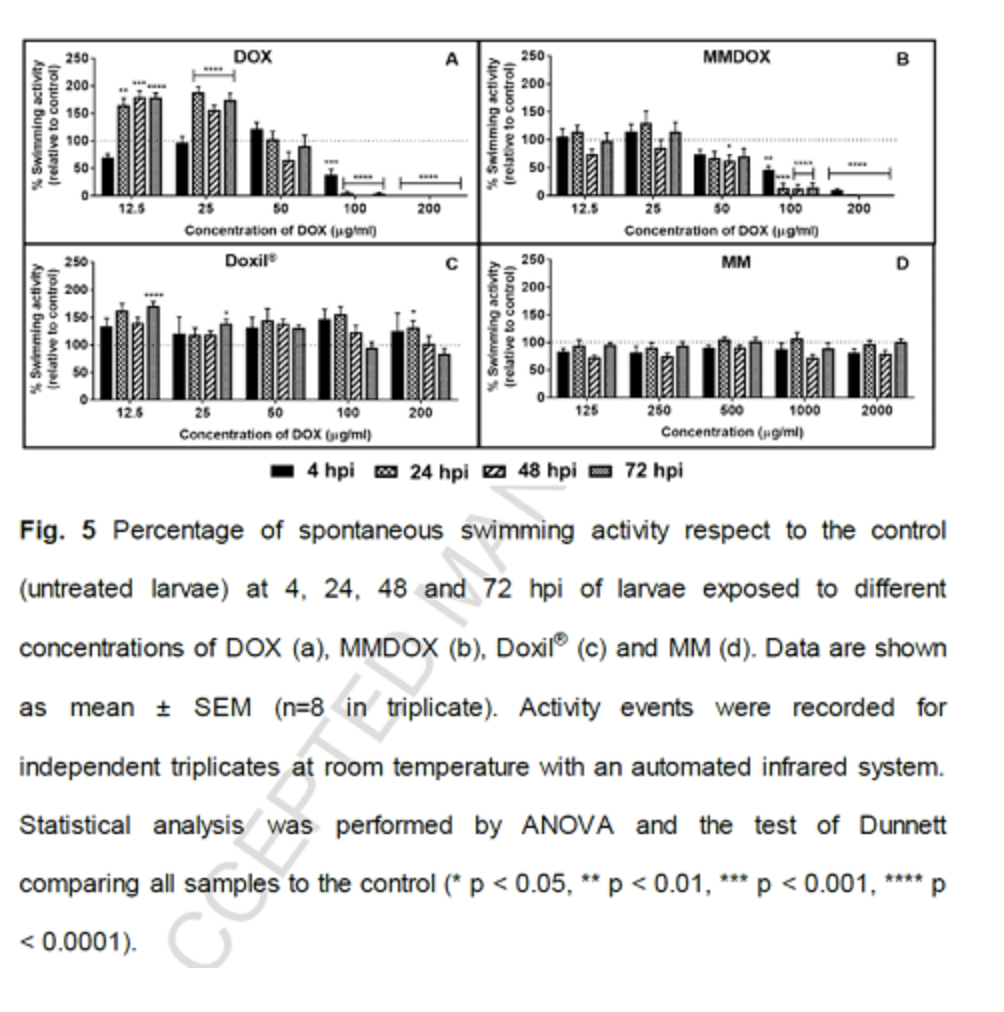
Doxorubicin (DOX) hydrochloride is a powerful anthracycline antibiotic used for the treatment of various types of malignancies, particularly ovarian and metastatic breast cancer. However, DOX presents severe side effects, such as hepatotoxicity, nephrotoxicity, dose-limiting myelosuppression, brain damage and cardio toxicity. A liposomal formulation, Doxil®, was approved by the FDA, which has managed to reduce the number of cardiac events in patients with metastatic breast cancer. However, in comparison to free DOX, Doxil® has not shown significant improvements regarding survival. We have previously designed DOX-loaded mixed micelles (MMDOX) composed of D-α-tocopheryl polyethylene glycol 1000 succinate (TPGS) and Tetronic® T1107. To assess the potential toxic effects of this novel formulation, in this work the zebrafish (Daniorerio) model was used to evaluate its in vivo toxicity and teratogenicity. This study evaluated and compared the effects of DOX exposure from different formulations (free DOX, MMDOX and Doxil®) on the swimming activity. Measurement of the alteration of the spontaneous swimming activity allows the prediction of neurotoxic effects in zebrafish larvae. High or low activity with respect to the control could be indicative of adverse effects.
Materials And Methods:
Swimming activity of larvae was determined with a WMicrotracker device. The 96-well microplate was recorded for 15 min at room temperature at 4, 24, 48 and 72 hpi (4, 5, 6 and 7 dpf). A total of eight wells per condition were measured in triplicate (DOX, MMDOX, Doxil®, and MM). The results were relativized to the untreated control and reported as the percent of swimming activity for each time.
Results:
The results of the swimming experiment are shown in Figure 5. The treatment with free DOX produced a significant increase of swimming activity at low concentrations (12.5 and 25 μg/ml) since 24 hpi and a significant decrease for high concentrations (100 and 200 μg/ml) since 4 hpi. On the other hand, only larvae exposed high concentrations of MMDOX (100 and 200 μg/ml) presented a significative decrease in the activity with respect to the control since 4 hpi. No significant alterations in the swimming activity of larvae were observed under treatment with MM and Doxil®. Regarding Doxil®, this apparent absence of neurotoxicity could be related again to the low rate of drug release from the liposome. The profile of behavior of larvae treated with MMDOX was similar to those treated with DOX only at high concentrations, while the MM did not alter the swimming activity. Therefore, the potential neurotoxic effect observed in zebrafish larvae would be associated with DOX but not with the vehicle. In this paper, we have evaluated and compared the main toxic side effects of free DOX and DOX-loaded nanoformulations on the preclinical zebrafish model. The encapsulation of DOX into the mixed micelles reduced the lethal effect, the morphological alterations and the neurotoxic effects of the drug. The DOX- associated toxicity of the mixed micellar formulation exhibited a substantial decrease compared with that of free DOX.

Toxicol Appl Pharmacol. 2018 Jul 19;357:106-114. doi: 10.1016/j.taap.2018.07.019
Calienni MN, Cagel M, Montanari J, Moretton MA, Prieto MJ, Chiappetta DA, Alonso SDV.
